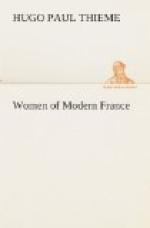French aristocracy really had no object, no raison d’etre, after its disappearance from all governmental functions; it became an encumbrance to the state; having no particular part to play, it did nothing; this is one of the causes of its dissolution and of the Revolution as well. Thus France gradually passed from inequality of classes under the sanction of custom to equality of classes before the law: this change in the condition and constitution of the French nobility accounts for many intrigues and scandals and explains the social and moral actions of French women, as well as the difference in the nature of their activities in the seventeenth and eighteenth centuries.
The seventeenth was, par excellence, the century which can boast of that incomparable society the cult of which was the highest in all things—art, religion, philosophy, poetry, politics, war, and beauty. From the convent of the Carmelites to the Hotel de Rambouillet, from the Place Royale to the various chateaux and salons, we must seek only that which is elevating and spiritual, beautiful and religious. In the famous society which kept pace with the political reputation and influence of France is found a coterie of women who combined remarkable beauty and intelligence with a high moral standard, and whose names are intimately connected with the history of France. Where again can we find such a galaxy of beauties as that formed by Charlotte de Montmorency, Mme. de Chevreuse, Mme. de Hautefort, Mme. de Montbazon, Mme. de Guemene, Mme. de Chatillon, Mme. de Longueville, Marie de Gonzague, Henriette de la Valliere, Mme. de Montespan, Mme. de Maintenon, without enumerating such great writers and leaders of salons as Mme. de Rambouillet, Mlle. de Scudery, Mme. de Lambert, Mme. de Sevigne, and Mme. de la Fayette? The seventeenth century could tolerate no mediocrity; grandeur was in the very atmosphere; its political movements were great movements; it produced in art a Poussin, in letters a Corneille, in science and philosophy a Descartes.
The various movements of which woman was the head may be divided into two periods, and each period into two parts. The political women may well be grouped about Marie de’ Medici,—whose career will not be given separate treatment, inasmuch as there was no drop of French blood in her veins,—and the social and literary women about Mme. de Rambouillet and her salon. In the latter half of the seventeenth century and at the beginning of the eighteenth, politics are represented by Mme. de Montespan—the mistress—and Mme. de Maintenon—the wife; social life and literature have their purest representative in Mme. de Lambert. The two queens of the seventeenth century, Anne of Austria and Maria Theresa, were without influence; the religious movement was represented by the galaxy of women of whom we write in a later chapter.




